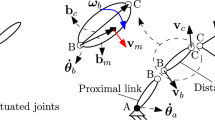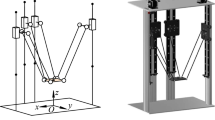Abstract
Redundant constraints are defined as those constraints which can be removed without changing the kinematics of the mechanism. They are usually eliminated from the mathematical model of a multibody system. For a given mechanism the set of redundant constraints can be chosen in many ways. Rigid body systems with redundant constraints do not have a unique solution to the problem of joint reaction forces calculation. If redundant constraints are present in the mechanical system, then the system is statically undetermined. If in the case of dynamics problem the constraints are consistent, all of them are frictionless and we are interested only in positions, velocities and accelerations of the bodies, then the calculation of joint reaction forces is not necessary. In many cases, however, e.g. when we want to take into account friction in joints, the calculation of joint reaction forces cannot be avoided. In some rigid body systems, despite the redundant constraints existence, reaction forces in selected joints can be uniquely determined. The paper presents three methods of finding the constraints for which reaction forces can be uniquely determined using rigid body model. Three different techniques of Jacobian matrix analysis are used.
Similar content being viewed by others
References
Haug, E. J., Computer Aided Kinematics and Dynamics of Mechanical Systems, Allyn and Bacon, Boston, MA, 1989.
Nikravesh, P. E., Computer-Aided Analysis of Mechanical Systems, Prentice Hall, New York, 1988.
Garcia de Jalon, J. and Bayo, E., Kinematic and Dynamic Simulation of Multibody Systems: The Real-Time Challenge, Springer, New York, 1994.
Park, T., Haug, E. J. and Yim, H. J., ‘Automated kinematic feasibility evaluation and analysis of mechanical systems’, Mechanisms and Machine Theory 23(5), 1988, 383–391.
Haug, E. J., Intermediate Dynamics, Prentice Hall, 1992.
Blajer, W., ‘On the determination of joint reactions in multibody mechanisms’, ASME Journal of Mechanical Design 126(2), 2004, 341–350.
Udwadia, F. E. and Kalaba, R. E., Analytical Dynamics: A New Approach, Cambridge University Press, Cambridge, 1996.
Corwin, L. J. and Szczarba, R. H., Multivariable Calculus, Marcel Dekker, New York, 1982.
Jungnickel, U., ‘Differential-algebraic equations in riemannian spaces and applications to multibody system dynamics’, ZAMM 74(9), 1994, 409–415.
Blajer, W., ‘A Geometrical interpretation and uniform matrix formulation of multibody system dynamics’, ZAMM 81(4), 2001, 247–259.
Strang, G., Linear Algebra and Its Applications, Academic Press, New York, 1980.
Author information
Authors and Affiliations
Corresponding author
Rights and permissions
About this article
Cite this article
Wojtyra, M. Joint Reaction Forces in Multibody Systems with Redundant Constraints. Multibody Syst Dyn 14, 23–46 (2005). https://doi.org/10.1007/s11044-005-5967-0
Received:
Accepted:
Issue Date:
DOI: https://doi.org/10.1007/s11044-005-5967-0




